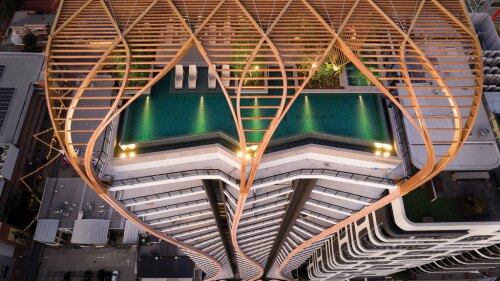Whether as small as a bus shelter or as large as a major train station, public transit buildings need to have a prominent profile in the streetscape so that riders can find them; ergo, aesthetics matter. So does circulation: the routes that passengers travel to get to and from the station or platforms—not to mention to and from different modes of transport—have to be quick and simple to navigate, especially during peak travel hours.
The following ten projects—all completed during the past five years—balance distinctive architecture with attention to easing passenger flows and linking to the surrounding context. They include an intermodal light-rail/commuter-rail station combined with a performance venue and open space, a light-rail station with a pedestrian/bicycle bridge that knits together a university campus, outdated stations replaced to better integrate into new development, and two major subway projects in New York City.
1. Arnhem Central Station
Arnhem, Netherlands
For decades, Arnhem’s train station occupied a small, poorly lit structure constructed in the 1950s as the city rebuilt after World War II bombing. In the 1990s, the national government teamed up with the municipality and commissioned UNStudio of Amsterdam to master-plan the station area with the goal of creating a major transit hub that serves as the city’s “front door.” In designing the station, UNStudio drew inspiration from the continuous inside/outside surface of the Klein bottle, the three-dimensional equivalent of a Möbius strip.
The ceilings, slanted walls, and floors flow seamlessly one to the other via “the Twist,” a sculptural element that provides load-bearing support and vertical connections while helping with wayfinding. Shipbuilders put together the undulating roof’s prefabricated steel panels with the same methods used to assemble boats. The terminal includes shops, a conference center, and underground parking. UNStudio also designed two bus stations—one for local and the other for regional connections—and two office towers as part of the complex. The station opened in 2015.
2. Blackburn Bus Station
Blackburn, United Kingdom
For decades, Blackburn’s bus riders waited in small, functional shelters across from the train station. Then, Blackburn with Darwen Council—the borough authority—decided to redevelop the bus station site as the mixed-use Cathedral Quarter and asked Capita, headquartered in London, to design a new bus facility adjacent to the town’s main shopping center.
Part of a larger effort to enhance the local bus network and encourage more people to use public transit, the new two-story facility is topped by a lightweight, glass-reinforced plastic canopy that extends over the glass-enclosed exterior walls. Beneath glazed slots cut into the canopy, sculptural metal “loops” painted white dangle at different heights, referencing Blackburn’s historic cotton-weaving looms. The six largest loops support the structure. The station includes 14 bus stalls, three layover spaces, and a café and retail kiosk. Completed in 2016, the station is designed to host public and community events.
3. Casa-Port
Casablanca, Morocco
Morocco’s national rail operator decided to replace the Casa-Port station to accommodate a projected increase in travelers to 25 million per year and to better integrate the station with planned redevelopment of the nearby waterfront and city center. The new facility is topped by a wood-and-steel roof held up by thin columns that branch like trees as they rise, with skylights directly above each column. The roof extends over the south facade to shade outdoor public spaces.
Glazed facades provide views to the exterior to help passengers find their way. A modern interpretation of the mashrabiya, the wooden lattice sunscreen of traditional Arab architecture, shields the west side of the building from direct afternoon sunlight. Designed by Paris-based AREP & Groupe 3 Architectes of Rabat, Morocco, and completed in 2014, the facility includes an underground parking structure, retail and service areas, and food courts.
4. Cermak-McCormick Place Station
Chicago, Illinois
In the late 1970s, with ridership of Chicago’s “L” declining in the Near South Side, the Chicago Transit Authority removed the Cermak station that served the Green Line. Four decades later, the city invested in a new gateway station to fill the gap left by the demolished facility and encourage development in the area, which includes one of the country’s largest convention centers, McCormick Place. The new station had to be constructed quickly, inexpensively, and without requiring service suspensions, and the narrow right-of-way left room for a center platform measuring only 15 feet wide (4.5 m).
Local firm Ross Barney Architects, with local associate architects UrbanWorks, devised a perforated stainless steel and polycarbonate tube that arches over the platform and tracks. The tube shelters passengers from the elements, lets in natural light, provides views, and offers a distinctive image when seen from a distance. To maximize the platform’s limited space, the tube has its own independent structural support. The station opened in 2015.
5. Fulton Center
New York, New York
Fulton Center brings together five subway stops built in the early 1900s and linked by a byzantine array of narrow, dark pedestrian corridors and ramps. The local office of Grimshaw created new entrances and exits; wider, brighter passageways; and clear signage to guide commuters accessing the nine subway lines that run through the facility. In addition, a new underground walkway leads to the new World Trade Center Transportation Hub to connect to PATH trains and two more subway lines.
Fulton Center’s 120-foot-high (37 m) atrium has a conical skylit dome that brings daylight deep into the platforms below, aided by the 900 reflective aluminum panels of an artwork called Sky Reflector-Net, created by a collaboration of Grimshaw, local artist and designer James Carpenter, and the local office of ARUP. Completed in 2014, the project also involved renovation and incorporation of the historic Corbin Building next door, which houses part of the transit station as well as office space.
6. Nørreport Station
Copenhagen, Denmark
Denmark’s busiest transit hub serves hundreds of thousands of passengers each day, bringing together commuter rail, regional rail, and rapid transit lines. But the station, built in the early 1900s, was dim, outdated, and difficult for pedestrians and bicyclists to reach: the main station entrances opened onto a traffic island sandwiched between two halves of a busy street.
Local firms Gottlieb Paludan Architects and COBE replaced the old facility with glass pavilions topped with rounded roofs. To optimize circulation, the designers restructured the public spaces based on a study of existing pedestrian and cyclist behavior, and they restricted vehicular traffic to just one side of the station. To give bicycle parking prominence without obstructing sight lines, “bicycle beds” are recessed slightly below grade, accommodating 2,500 bikes. Extensive use of glass throughout maximizes visibility and helps arriving passengers get their bearings. Vegetated roofs absorb stormwater. The new facility opened in 2015.
7. QLINE Stations
Detroit, Michigan
A consortium of private investors formed a nonprofit organization, M-1 Rail, and partnered with local, state, and federal governments to accomplish the unlikely: a streetcar line for the Motor City’s downtown. Local firm Rossetti worked with M-1 and the local office of AECOM to design 20 stations along a 3.3-mile (5.3 km) stretch of Woodward Avenue. The goal was to create distinctive shelters that would combine transparency and durability while blending harmoniously into the city.
Constructed of anti-graffiti precast concrete and laminated glass, each QLINE station incorporates a different color of tiles made by a local tile manufacturer. Each shelter has its own corporate sponsor, noted with a plaque, and comes equipped with bench seating, heating, ticket vending machines, next-vehicle alert screens, and an emergency phone. The stations also provide access to free wi-fi, as do the streetcars themselves. After the system opened in May 2017, sponsors enabled free fares through early September to encourage ridership.
8. Second Avenue Subway
New York, New York
In 1929, New York City’s transportation authority set aside money for a Second Avenue subway, intending to relieve congestion on the Fourth Avenue line that runs up Manhattan’s East Side. Then the Great Depression hit and the plans foundered. Nearly 90 years later, on New Year’s Day 2017, the first piece of the revived project came to fruition, relieving pressure on the subway’s 4, 5, and 6 lines—the first major expansion of the system in half a century. Ultimately, the plan is to extend the line to East Harlem.
For this two-mile (3 km) stretch, the local offices of AECOM and ARUP renovated one station and added three more, drawing on pedestrian modeling to inform circulation paths for optimal flow. Glass and stainless-steel awnings cover station entrances at the street level. The new stations have high-ceilinged, column-free mezzanines and platforms to enhance visibility and minimize obstructions for commuters hurrying to catch trains. The mezzanines incorporate large-scale works by noted artists, including Chuck Close, Vik Muniz, and Sarah Sze.
9. Target Field Station
Minneapolis, Minnesota
Target Field Station combines intermodal transit connections with open space and a performance venue. Steps from the baseball stadium where the Minnesota Twins play, in the North Loop neighborhood of Minneapolis, Hennepin County built the new station to connect an existing light-rail line, a brand-new light-rail line, commuter rail, bus lines, and walking/biking trails.
Designed by New York–based Perkins Eastman and opened in 2014, the aboveground station has a canopy lined with programmable light-emitting diode (LED) lights to give it prominence. The station opens onto the “Great Lawn,” which doubles as a site for concerts and other events, and includes a 1,000-seat outdoor amphitheater, an urban plaza, office space, restaurants, and shops. A large video board above the station’s elevator core broadcasts games and other special events. To keep the plaza free of snow during the winter, the design team integrated a snowmelt system into walkways and stairs, borrowing waste heat from the Hennepin Energy Recovery Center (HERC) next door. A stormwater capture system stores and returns water to the HERC.
10. University of Washington Station
Seattle, Washington
Seattle’s transit authority extended its light-rail service from downtown to the University of Washington’s Husky Stadium, which sits at one of the city’s busiest street intersections, Montlake Boulevard and Pacific Street. Designed by local firm LMN Architects and opened in 2016, the University of Washington Station includes a pedestrian/bicycle bridge that crosses over multiple lanes of traffic to link the station and stadium on the east side of Montlake to the main campus on the west.
A grand plaza at the station’s entrance accommodates crowds attending stadium events. The station’s two-story-high central chamber is clad in glass, framing views to the Cascade Mountains. As passengers ride the escalator and glass elevator down to the platform 100 feet (30 m) below street level, they pass a massive artwork called Subterraneum, which is integrated into the walls. Local artist Leo Saul Berk arranged the installation’s backlit, perforated metal panels to recall the geological layers of earth excavated to make the station.
Ron Nyren is a freelance architecture and urban design writer based in the San Francisco Bay area.



















